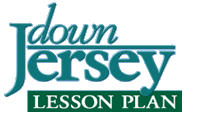 |
|
|||
Objectives Students will be able to:
Materials Worksheets Map of Cumberland County Copies of name cards and description cards for matching game Making Connections Cumberland County has a long history rich with interesting settlements, businesses and industries, and people from all over the world and from all walks of life. The film Down Jersey addresses some of the people and places that make this region so unique. Naming of places — towns, cities, and villages is often done by association and physical features of an area, as well as significant events that occurred in a particular place. This activity explores some of the town names of today and compares them to their former names. This knowledge would be especially critical if you were examining historical papers or books. As you will see, many of the towns’ names have been changed throughout history — some more than once! Background Almost the entire Historic Themes and Resources book addresses the name(s) of places/towns that once were part of the region Down Jersey and played a role in developing its unique character and ambiance. By Don Keen, author of From Whence We’ve Come. Some of the former names refer to areas within the present boundaries of a town while others were the actual name that preceded its present name. The clues I have provided often refer to the history of the town or county, thereby becoming a teaching tool in and of themselves. It is hoped this will pique the interest of the student to want to learn more. For instance, there are references to two skirmishes in Cumberland County during the Revolutionary War. Perhaps a student would do further research to learn the specifics of these and other ways in which we contributed to the war. There are many references to find the information contained in this lesson. One I used would be reasonably easy reading for fourth through sixth graders. It is "The Cumberland Story" and can be found for research or purchase at the W. E. Lumus Library of the Cumberland County Historical Society on Ye Greate Street in Greenwich. The clues and how they relate to each town can also be found in my book, From Whence We’ve Come. Procedure Warm Up The Activity
Wrap Up Assessment Students complete the worksheet and match all of the towns’ current names with their former names. Extensions Each student is assigned a town to write a short report about its history. These could then be assembled into a class newspaper and shared with others in the school and community. A classroom bulletin board/ map could be made showing the Cumberland County from the past, with the former names used in place of the current town names. This activity could be easily adapted to either Salem or Cape May Counties, or any other. Students choose one town and create a possible "folktale" about how it got its name. Please download the PDF for the complete Lesson Plan.
Historic Themes and Resources — Especially Chapter Two: Urban Development, pages 9-39 From Whence We’ve Come by Don Keen contains many interesting facts and photographs about the history of Cumberland County. This activity was adapted directly from this book. Your local library and historical society can provide much of the needed background information for this activity. See also the activity "Where Are You? The County." |
|||

 Charting the Course
Charting the Course